INDEX OF TIPS 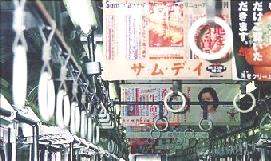 Tokyo is the largest metropolitan area in the world with population of 30 million, and has an extensive network of trains. JR and subway lines cover the central districts. Both JR and private railways' lines radiate from the several large terminal stations to surrounding suburban areas. Besides, there are often through train services from subway to the suburban lines so you can go directly from downtown to the residential areas outside. They provide quite frequent services throughout the day. They usually operate from five o'clock in the morning till twelve or one o'clock at night. From one to five in the midnight, neither train nor alternative bus services are available in Tokyo. Terribly expensive taxi with 'midnight supplement' is the only one transport during that period.
Tokyo is the largest metropolitan area in the world with population of 30 million, and has an extensive network of trains. JR and subway lines cover the central districts. Both JR and private railways' lines radiate from the several large terminal stations to surrounding suburban areas. Besides, there are often through train services from subway to the suburban lines so you can go directly from downtown to the residential areas outside. They provide quite frequent services throughout the day. They usually operate from five o'clock in the morning till twelve or one o'clock at night. From one to five in the midnight, neither train nor alternative bus services are available in Tokyo. Terribly expensive taxi with 'midnight supplement' is the only one transport during that period. Stopping stations of the train should be checked carefully because various kinds of trains are often operated in the same line: express (kyuko), semi-express (junkyu), rapid (kaisoku), special rapid (tokubetsu-kaisoku), commuter rapid (tsukin-kaisoku), commuter rapid express (tsukin-kaisoku-kyuko), and so on. Trains in Tokyo are notorious for congestion. It is not unusual that station staffs push passenger into heavily packed train's door as if you put clothes into the small bag when you prepare to travel. In the morning, around 7:30 to 9:00 is the worst. In the evening, congestion begins from around 17:00 to even midnight. Owing to the custom of drinking with co-workers, longer working hours than Western countries, and many attractive entertainments in downtown at night, many people tends to remains downtown in Tokyo at night compared with other cities. The later at night, the worse situation may be because many of them are drunken, especially on Friday. Even during daytime aside from rush hours, trains in some major lines or faster rapid services are often packed with as many passengers as the busiest hours. One of the notable aspects in Tokyo's trains different from other countries is that many passengers (regardless of sex or age) are sleeping in the train. Some of them are really fallen asleep, opening their mouth with very peaceful faces. Facts mentioned above are almost same in the case of Kansai area (Osaka, Kyoto, Kobe, Nara), although congestion is not so heavy as in Tokyo. Tickets and cost Tickets are bought in vending machines each time when getting on trains. Tokyo's rail networks are operated by many different companies, JR East, two different subway operators, Tokyo Metro and Toei Subway (Tokyo public subway) and many private suburban railways. It is a little inconvenient that you often have to buy another ticket when transferring to different company though sometimes through ticket is available at ticket machine. What is worse, cost gets higher when using different companies than going by only one company. So if you would like to cut cost seriously, it is better to stick to the same company's line and avoid transfer such as JR and subway or Tokyo Metro and Toei subway. Useful Rail Pass
Major rail lines Tokyo has complex rail networks, but many of those lines aim at commuters moving between suburbs and business centers, which is not so convenient for sightseeing and shopping purpose for visitors from outside Tokyo. Among them, JR Yamanote Line and Tokyo Metro Ginza Line are the most useful line for tourists. JR Yamanote Line This is the loop line connecting major places in central Tokyo. Tokyo, Shinbashi, Shinagawa, and Ueno are important business and commercial centers in eastern old center. Ginza, the central commercial district in central Tokyo, is several minutes walk from Yurakucho station, and Akihabara, the famous shopping center of electric goods, is on the way. In the western half of this line, Yamanote line also connects busy sub centers, Shibuya, Shinjuku and Ikebukuro. In western part of this line, train is heavily crowded mainly dominated by young people throughout the day, while eastern part rather orients to business and commuting demand mainly middle-aged men wearing gray suits. JR Chuo line This line connects directly between Tokyo (central) station and Shinjuku by rapid service, the fastest rail service between those two centers. Tokyo Metro Ginza Line This is the oldest subway line in Tokyo and East Asia, opened in 1927. Ginza line connects the most important and busiest commercial centers in Tokyo, being crowded not only during rush hours of commuters but also during the day by people doing shopping. Asakusa was once important center, now becoming tourist attraction with Sensoji temple and the atmosphere of old Tokyo. Then Ginza line goes along Central Street, the central commercial district, connecting Ueno, Nihonbashi, Ginza and Shinbashi. Turning to west, Ginza line goes under Aoyama Street, which is a little high-class shopping area popular for fashionable women. And the train arrives at Shibuya, the hub of Tokyu railways radiating to western suburbs. Tokyo Metro Marunochi Line The second oldest line opened in 1954. It covers the most important business centers in Tokyo, Shinjuku, Kasumigaseki, Otemachi and Ikebukuro. Brief Guide of Getting around Tokyo The aim of this Tokyo guide is to help you get a brief image about places in Tokyo, get some idea about each places like local people, rather than concrete and practical information about museums, shops, restaurants or transport like travel guide books. 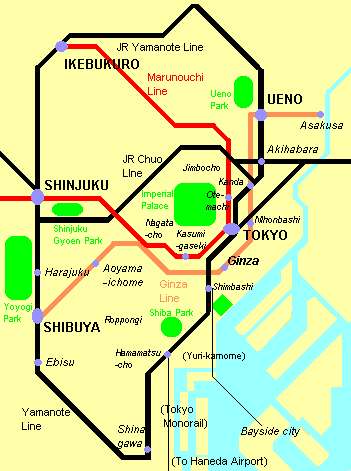 Old center 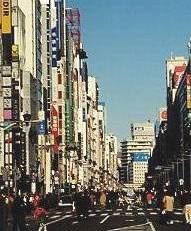 Eastern side of Tokyo station such as Ginza and Nihonbashi is busy commercial area and the old center of Tokyo. Ginza is regarded as the most famous commercial district in Tokyo. One of the notable aspects of commercial centers in Japan is that they are dominated by young people. Judging by the standard of Japan, Ginza is a place for matured adult people, and retains some high-class atmosphere with many boutiques and department stores. Department stores selling every kind of goods had been star player in Japanese retail industry. But these days they are said to be rather outdated, due to the diversified taste of consumers (mainly young people) and the rise of specialized shops or discount stores covering such demands.
Eastern side of Tokyo station such as Ginza and Nihonbashi is busy commercial area and the old center of Tokyo. Ginza is regarded as the most famous commercial district in Tokyo. One of the notable aspects of commercial centers in Japan is that they are dominated by young people. Judging by the standard of Japan, Ginza is a place for matured adult people, and retains some high-class atmosphere with many boutiques and department stores. Department stores selling every kind of goods had been star player in Japanese retail industry. But these days they are said to be rather outdated, due to the diversified taste of consumers (mainly young people) and the rise of specialized shops or discount stores covering such demands. 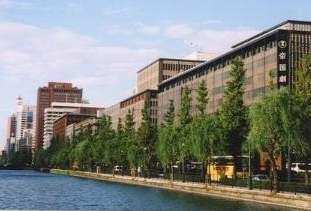 Western side of Tokyo station is the central business district of Japan. Head offices of large companies concentrate Marunouchi and Otemachi area. Kasumigaseki is the hub of administrative offices. Nagatacho has parliament and other offices for politicians. These places have well-organized urban landscape with wide, straight streets and large buildings, which is uncommon in Japanese cities.
Western side of Tokyo station is the central business district of Japan. Head offices of large companies concentrate Marunouchi and Otemachi area. Kasumigaseki is the hub of administrative offices. Nagatacho has parliament and other offices for politicians. These places have well-organized urban landscape with wide, straight streets and large buildings, which is uncommon in Japanese cities. There are some other interesting places around central Tokyo. Jimbocho is huge concentration of many specialised second-hand bookshops. Some shops specialise in foreign books. Jimbocho and neighboring Kanda area is also good for buying sports equipment with many discount shops of exercise goods. Akihabara is famous for many electric discount stores. Street is dominated by gaudy signs and loud advertisement, may worth seeing even if you have no intention of checking electric goods. Western Tokyo Relatively newer city than eastern area, western sub-center had grown fast and now pretty lively, especially in terms of commercial area. Shinjuku, Shibuya and Ikebukuro is the three most busiest centers, being the hub of suburban private railways. Streets in these towns are heavily jammed by many people every day until midnight, which might be the most congested place in the world. Shinjuku station is the busiest in Japan used by three million passengers every day. Eastern side of Shinjuku is chaotic commercial center with every kind of shops and enjoyed by every kind of people from teenagers to middle-aged. On the contrary western side is mainly business district of many skyscrapers, though there are some department stores and discount shops of electric goods. You can go to the top floor of Tokyo metropolitan government building free of charge and enjoy very good observation, perhaps better than Tokyo tower with expensive fee.
The character of Ikebukuro seems to be similar to Shinjuku rather than Shibuya. Harajuku is dominated by teenager students. Aoyama area is shopping area oriented to fashionable, high-class atmosphere with many boutiques. Roppongi is the 'disco capital' of Japan. Ebisu is recently re-developed and has fine shopping complex 'Ebisu Garden Place'. Eastern Tokyo 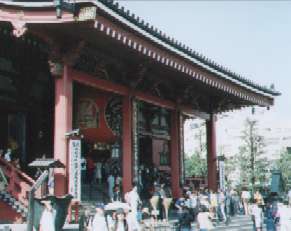 Although it is older urban area than west, eastern area seems to be outgrown by western commercial centers. Still it is interesting area to walk around, retaining the atmosphere of old Tokyo. Ueno has interesting shopping market called 'Ameya Yokocho' in which many small shops of clothing, food, and many other kinds of goods cluster. You may expect some good bargain or unexpected findings here. Ueno park is also good place to enjoy culture with Tokyo National Museum, National museum of Western Art, Tokyo Metropolitan Musekum of Art, Ueno Zoo, and so on. Asakusa is once major commercial center but now seems to be a kind of tourist attraction with Senso-ji temple and the atmosphere of old Tokyo.
Although it is older urban area than west, eastern area seems to be outgrown by western commercial centers. Still it is interesting area to walk around, retaining the atmosphere of old Tokyo. Ueno has interesting shopping market called 'Ameya Yokocho' in which many small shops of clothing, food, and many other kinds of goods cluster. You may expect some good bargain or unexpected findings here. Ueno park is also good place to enjoy culture with Tokyo National Museum, National museum of Western Art, Tokyo Metropolitan Musekum of Art, Ueno Zoo, and so on. Asakusa is once major commercial center but now seems to be a kind of tourist attraction with Senso-ji temple and the atmosphere of old Tokyo. Bay side area 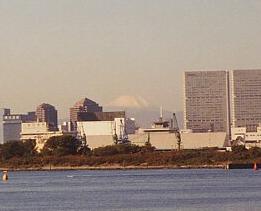 Tokyo has been extending to bay area filling up the sea and making new lands. Bay area is developed aiming to make new business center of Tokyo. This purpose is not well achieved due to the long recession of Japan, but instead Bay area is attracting people for sightseeing purpose. 'Yuri-kamome (seagull)', new transport to bay area, looks like an attraction of an amusement park rather than practical railway, though it provides very nice view from high elevated track. With fine view of sea and large open space quite rear in other Japanese city, it is pleasant place to walk around.
Tokyo has been extending to bay area filling up the sea and making new lands. Bay area is developed aiming to make new business center of Tokyo. This purpose is not well achieved due to the long recession of Japan, but instead Bay area is attracting people for sightseeing purpose. 'Yuri-kamome (seagull)', new transport to bay area, looks like an attraction of an amusement park rather than practical railway, though it provides very nice view from high elevated track. With fine view of sea and large open space quite rear in other Japanese city, it is pleasant place to walk around. |
